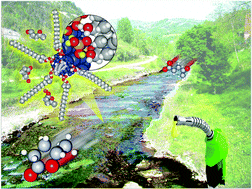Interfacial acidity in ligand-modified ruthenium nanoparticles boosts the hydrogenation of levulinic acid to gamma-valerolactone
Gamma-valerolactone (GVL), a versatile renewable compound listed among the top 10 most promising platform chemicals by the US Department of Energy, is produced via hydrogenation of levulinic acid (LA). The traditional high-loading ruthenium-on-carbon catalyst (5 wt% Ru) employed for this transformation suffers from low metal utilisation and poor resistance to deactivation due to the formation of RuOx species. Aiming at an improved catalyst design, we have prepared ruthenium nanoparticles modified with the water-soluble hexadecyl(2-hydroxyethyl)dimethylammonium dihydrogen phosphate (HHDMA) ligand and supported on TiSi2O6. The hybrid catalyst has been characterised by ICP-OES, elemental analysis, TGA, DRIFTS, H2-TPR, STEM, EDX, 31P and 13C MAS-NMR, and XPS. When evaluated in the continuous-flow hydrogenation of LA, the Ru-HHDMA/TiSi2O6 catalyst (0.24 wt% Ru) displays a fourfold higher reaction rate than the state-of-the-art Ru/C catalyst, while maintaining 100% selectivity to GVL and no sign of deactivation after 15 hours on stream. An in-depth molecular analysis by Density Functional Theory demonstrates that the intrinsic acidic properties at the ligand–metal interface under reaction conditions ensure that the less energy demanding path is followed. The reaction does not obey the expected cascade mechanism and intercalates hydrogenation steps, hydroxyl/water eliminations, and ring closings to ensure high selectivity. Moreover, the interfacial acidity increases the robustness of the material against ruthenium oxide formation. These results provide valuable improvements for the sustainable production of GLV and insights for the rationalisation of the exceptional selectivity of Ru-based catalysts.

D. Albani, Q. Li, G. Vilé, S. Mitchell, N. Almora-Barrios, P.T. Witte, N. López, J. Pérez-Ramírez
Green Chem. 2017, 19, 2361-2370
DOI:
10.1039/C6GC02586B

Let's create a brighter future
Join our team to work with renowned researchers, tackle groundbreaking
projects and contribute to meaningful scientific advancements




















